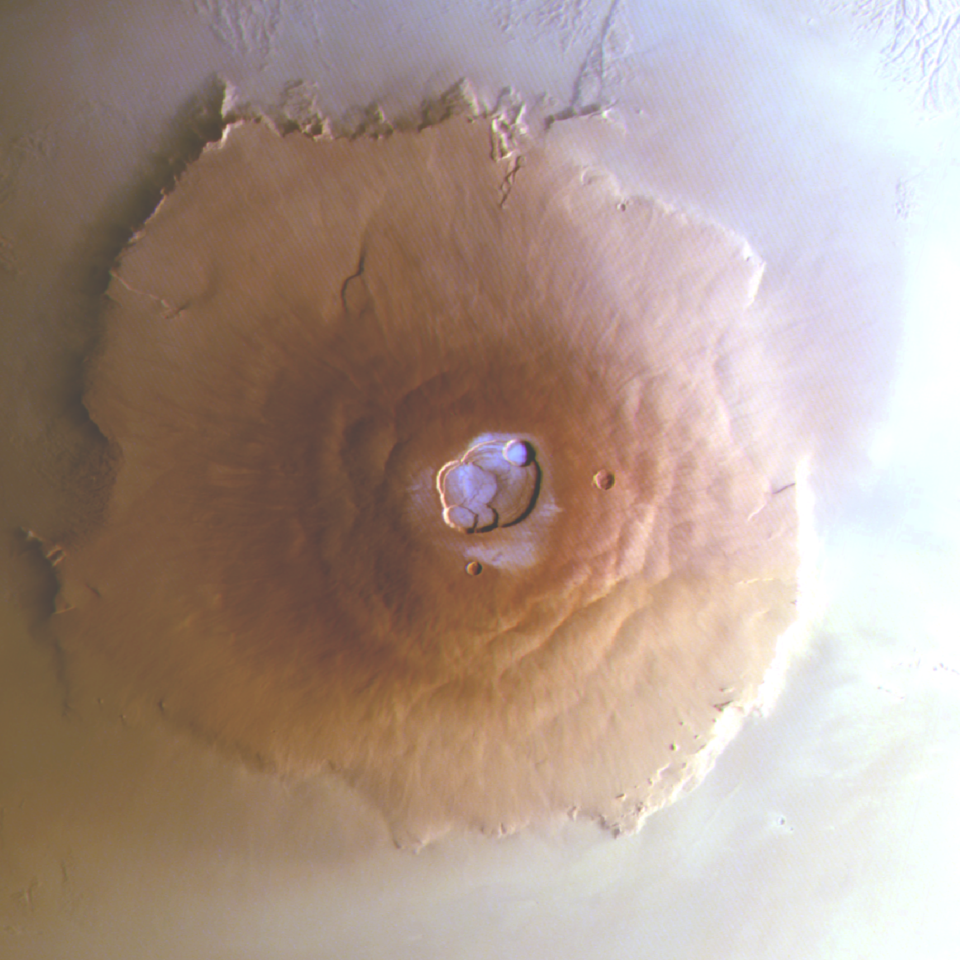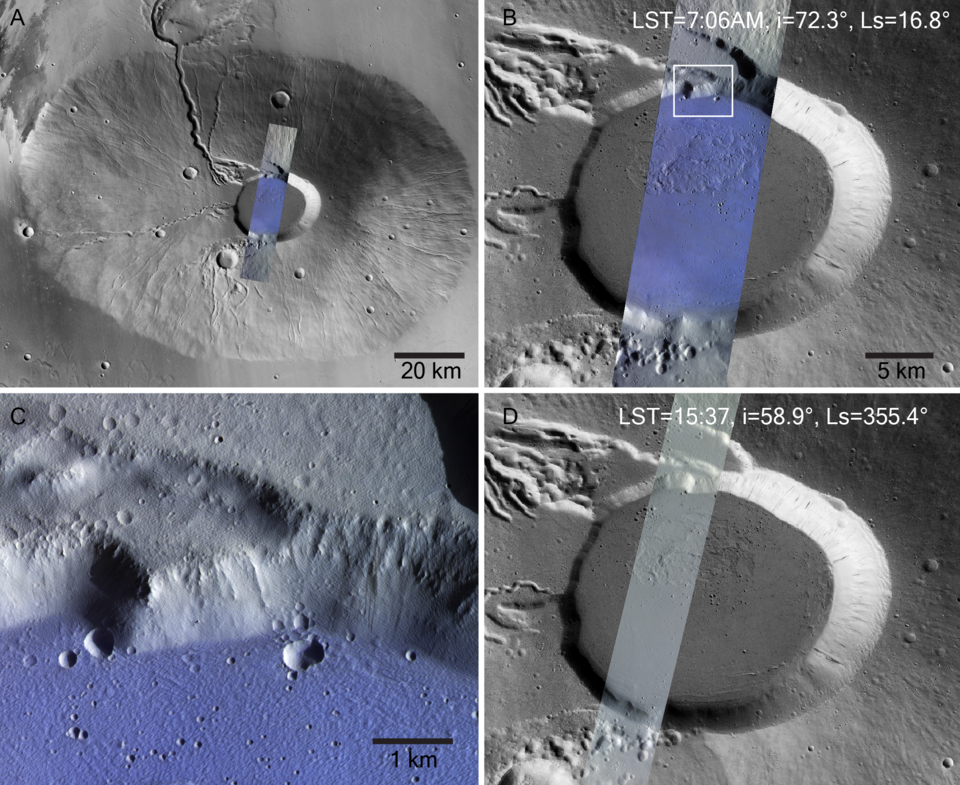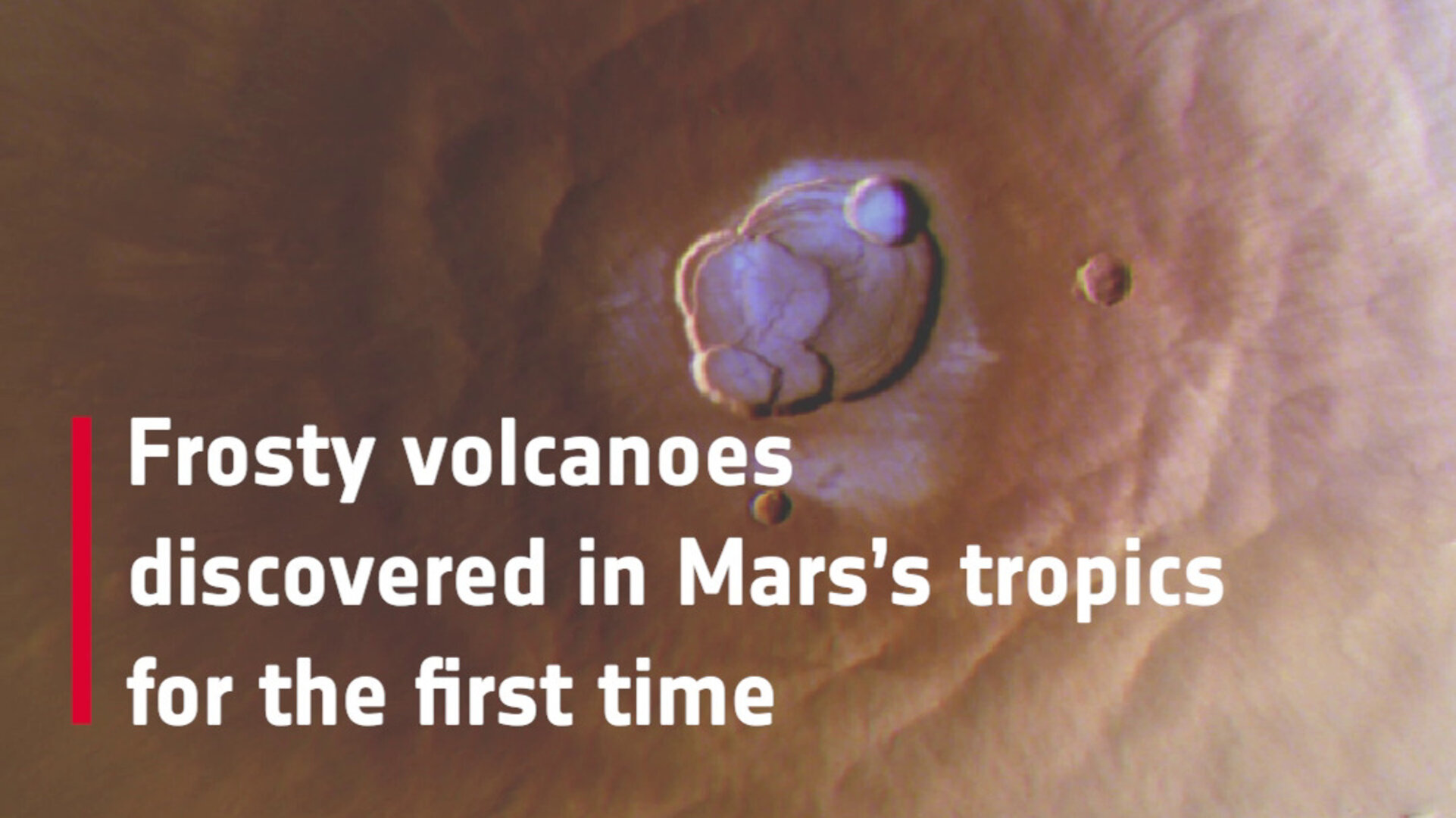Frosty volcanoes discovered in Mars’s tropics
ESA’s ExoMars and Mars Express missions have spotted water frost for the first time near Mars’s equator, a part of the planet where it was thought impossible for frost to exist.
The frost sits atop the Tharsis volcanoes: the tallest volcanoes not only on Mars but in the Solar System. It was first seen by ESA’s ExoMars Trace Gas Orbiter (TGO), and later by both another instrument aboard TGO and ESA’s Mars Express.
“We thought it was impossible for frost to form around Mars’s equator, as the mix of sunshine and thin atmosphere keeps temperatures relatively high at both surface and mountaintop – unlike what we see on Earth, where you might expect to see frosty peaks,” says lead author Adomas Valantinas, who made the discovery as a PhD student at University of Bern, Switzerland, and is now a postdoctoral researcher at Brown University, USA.

“Its existence here is exciting, and hints that there are exceptional processes at play that are allowing frost to form.”
The patches of frost are present for a few hours around sunrise before they evaporate in sunlight. Despite being thin – likely only one-hundredth of a millimetre thick (as thick as a human hair) – they cover a vast area. The amount of frost represents about 150,000 tonnes of water swapping between surface and atmosphere each day during the cold seasons, the equivalent of roughly 60 Olympic swimming pools.
A peculiar microclimate

The Tharsis region of Mars hosts numerous volcanoes, including Olympus Mons and the Tharsis Montes: Ascraeus, Pavonis and Arsia Mons. Many of these volcanoes are colossal, towering above the surrounding plains at heights ranging from one (Pavonis Mons) to three (Olympus Mons) times that of Earth’s Mount Everest.
These volcanoes have calderas, large hollows, at their summits, caused as magma chambers emptied during past eruptions. The researchers propose that air circulates in a peculiar way above Tharsis; this creates a unique microclimate within the calderas of the volcanoes there that allows patches of frost to form.
“Winds travel up the slopes of the mountains, bringing relatively moist air from near the surface up to higher altitudes, where it condenses and settles as frost,” says co-author Nicolas Thomas, Principal Investigator of TGO’s Colour and Stereo Surface Imaging System (CaSSIS) and Adomas’s PhD supervisor at the University of Bern. “We actually see this happening on Earth and other parts of Mars, with the same phenomenon causing the seasonal martian Arsia Mons Elongated Cloud.

“The frost we see atop Mars’s volcanos appears to settle in the shadowed regions of the calderas especially, where temperatures are colder.”
Adomas, Nicolas and colleagues spotted frosts on the Tharsis volcanoes of Olympus, Arsia and Ascraeus Mons, and Ceraunius Tholus. Modelling how these frosts form could allow scientists to reveal more of Mars’s remaining secrets, including where water exists and how it moves between reservoirs, and understanding the planet’s complex atmospheric dynamics. Such knowledge is essential for our future exploration of Mars, and our search for possible signs of life beyond Earth.
Unexpected and compelling
This discovery marks the first time frost has been found at Mars’s equator. But why had it not been spotted before?
“There are a few reasons: firstly, we need an orbit that lets us observe a location in the early morning. While ESA’s two Mars orbiters – Mars Express and TGO – have such orbits and can observe at all times of day, many from other agencies are instead synchronised to the Sun and can only observe in the afternoon,” adds Adomas.
“Secondly, frost deposition is linked to colder martian seasons, making the window for spotting it even narrower. In short, we have to know where and when to look for ephemeral frost. We happened to be looking for it near the equator for some other research, but didn't expect to see it on Mars’s volcano tops!”

Discovering the frost relied upon collaboration between two of ESA’s orbiting Mars explorers: ExoMars TGO and Mars Express.
TGO arrived at Mars in 2016 and has been imaging and mapping Mars’s surface, atmosphere and water since its full science mission began in 2018. Mars Express has been orbiting Mars since 2003, and has spent two decades exploring Mars’s surface, subsurface, minerals, phenomena and atmosphere.

The research team spotted the frost with TGO’s CaSSIS instrument. They then confirmed their finding by looking again at the area using TGO’s Nadir and Occultation for Mars Discovery (NOMAD) spectrometer and Mars Express’s High Resolution Stereo Camera (HRSC).
“Finding water on the surface of Mars is always exciting, both for scientific interest and for its implications for human and robotic exploration," says Colin Wilson, ESA project scientist for both ExoMars TGO and Mars Express. “Even so, this discovery is particularly fascinating. Mars’s low atmospheric pressure creates an unfamiliar situation where the planet's mountaintops aren’t usually colder than its plains – but it seems that moist air blowing up mountain slopes can still condense into frost, a decidedly Earth-like phenomenon.
“This discovery was possible thanks to successful collaboration between both of ESA’s Mars orbiters, and additional modelling. Understanding exactly which phenomena are the same or different on Earth and Mars really tests and improves our understanding of basic processes happening on not only our home planet, but elsewhere in the cosmos.”


Access the video
Notes for editors
‘Evidence for transient morning water frost deposits on the Tharsis volcanoes of Mars’ by Valantinas et al. is published in Nature Geoscience [DOI: 10.1038/s41561-024-01457-7].
For more information, please contact:
ESA Media Relations
media@esa.int














 Germany
Germany
 Austria
Austria
 Belgium
Belgium
 Denmark
Denmark
 Spain
Spain
 Estonia
Estonia
 Finland
Finland
 France
France
 Greece
Greece
 Hungary
Hungary
 Ireland
Ireland
 Italy
Italy
 Luxembourg
Luxembourg
 Norway
Norway
 The Netherlands
The Netherlands
 Poland
Poland
 Portugal
Portugal
 Czechia
Czechia
 Romania
Romania
 United Kingdom
United Kingdom
 Slovenia
Slovenia
 Sweden
Sweden
 Switzerland
Switzerland


























